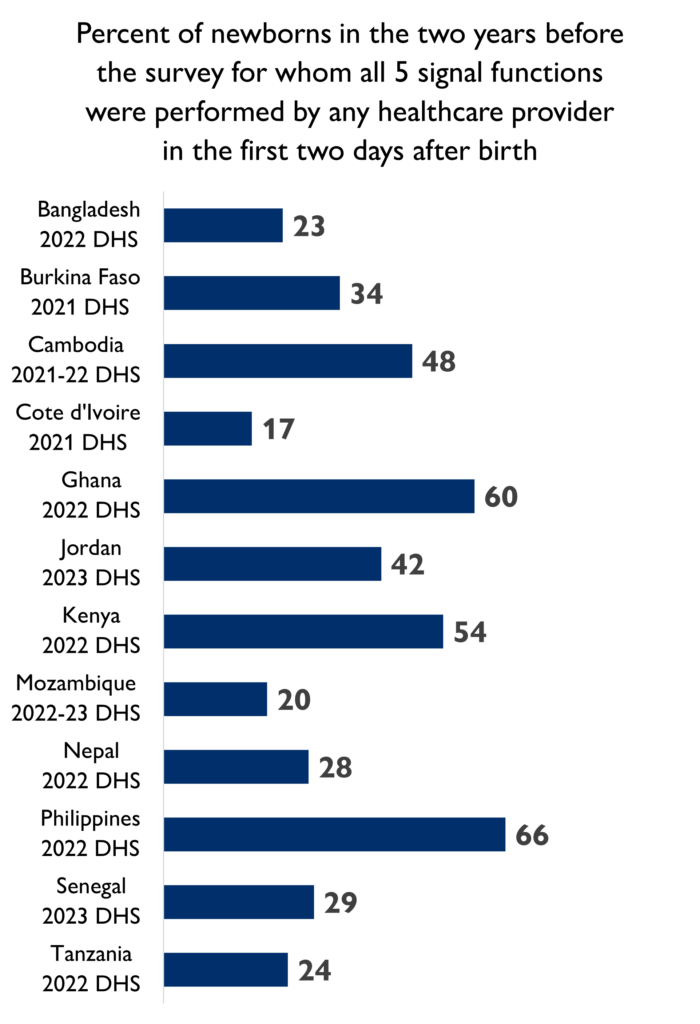New in DHS-8: Updates to Postnatal Care (PNC) Indicators

In 2019, The DHS Program released updated questionnaires for the eighth phase of The DHS Program (DHS-8) to better meet existing and emerging data needs in global health. This “New in DHS-8” series draws attention to new indicators, changes made to existing indicators, and other things DHS Program data users should be aware of when accessing DHS-8 final reports and datasets.
The days and weeks following childbirth are the postnatal period, a vulnerable phase in the lives of mothers and newborns. Postnatal care (PNC) refers to the care provided to the mother and newborn immediately after birth and during the first six weeks of life. DHS Program surveys collect information on three key components of PNC:
- Timing of the first postnatal checkup for both mothers and newborns
- Type of provider for the postnatal checkup for both mothers and newborns
- Content of PNC for newborns
PNC indicators can be found in the Maternal and Newborn Health Care chapter of DHS survey final reports.
Expanded Sample and New Reference Period
Before 2019, questions about PNC were asked about women’s most recent live birth in the six years before the survey. However, PNC is important for all women to receive after experiencing a birth, whether a live or stillbirth. The DHS-8 woman’s questionnaire asks PNC questions of women who experienced stillbirths in addition to live births, but now only asks women about PNC for births in the three years before the survey.
New Dataset
With DHS-7 surveys, the Kid’s Recode (KR) data files can be used to replicate PNC indicators found in the final report tables. The KR file contains information on the children under age 5 of interviewed women. DHS-8 surveys now include a new data file, the Pregnancy and Postnatal Care Recode (NR). The NR data file was created with pregnancies as the unit of analysis because DHS-8 surveys now include a full pregnancy history. The NR data file includes all pregnancies from women in the three years before the survey, regardless of the pregnancy outcome.
Data users should be aware of some variable changes that will affect analysis. First, a new variable, p19, is now included as the number of months since the pregnancy outcome. For currently living children, this is the same as their current age in months. For all other pregnancy outcomes, this is the number of months since the pregnancy ended. Secondly, the new variable, m80 classifies pregnancy outcomes as the most recent live birth, the most recent stillbirth, a prior live birth, a prior stillbirth, or a miscarriage or abortion.
Expanded Content of PNC
The DHS-8 Woman’s Questionnaire now standardly asks women with births in the three years before the survey about the content of postnatal care for the mother, including whether:
- her blood pressure was measured during a PNC check
- any healthcare provider discussed vaginal bleeding with her
- family planning was discussed
Over half of new mothers in the Philippines received all three checks in the first two days after birth, compared to just 17% of new mothers in Bangladesh and Cote d’Ivoire.
DHS questionnaires are adapted to each country so surveys may include additional questions and modules. For instance, in the 2023 Jordan Population and Family Health Survey, women were also asked if any healthcare provider asked about problems with urination, if she had any pain, and about feeling sad or depressed.

Women are asked whether any healthcare provider performed each of the five signal functions[1] in the two days after birth:
- examined the umbilical cord
- measured the newborn’s temperature
- mother told about danger signs and how to recognize if the newborn needs immediate medical attention
- mother counseled on and observed breastfeeding
- newborn weighed
DHS-7 surveys present information on newborns for whom at least two signal functions were performed during the first two days after birth. DHS-8 surveys now present information on those newborns for whom all five signal functions were performed during the first two days after birth.
For over half of newborns in the Philippines (66%), Ghana (60%) and Kenya (54%) all five signal functions were performed. In contrast, all five signal functions were performed for only 20% of newborns in Mozambique and 17% in Cote d’Ivoire.
The code for PNC variables in DHS-7 and DHS-8 surveys can be found in The DHS Program code library on GitHub.
The Guide to DHS Statistics includes complete definitions of the PNC indicators and notes on changes over time.
Data users can also check out The DHS Program User Forum for help with specific questions about tabulating postnatal care indicators.
Feature image © Suaahara II accessed from the USAID Advancing Nutrition-UNICEF IYCF Digital Image Bank (iycf.advancingnutrition.org)
[1] Corresponds to the definition of the five signal functions to assess the content of postnatal care for newborns described in Moran et al. 2013.







Un article intéressant à tout point de vue. La consultation Post natal est aussi importante pour la mère et l’enfant. Pour les prochaines études , on pourrait associer le volet des agents de santé communautaire.